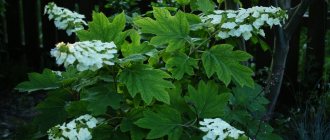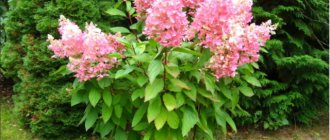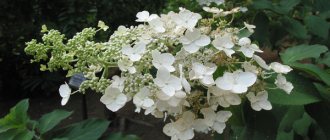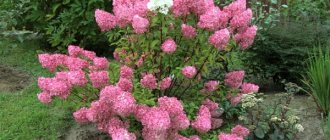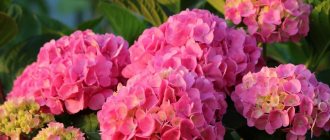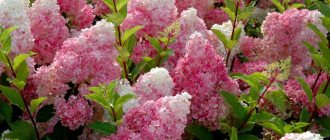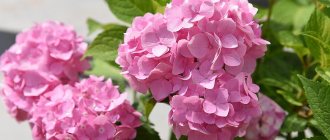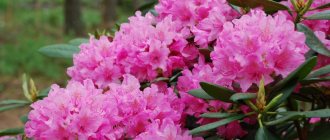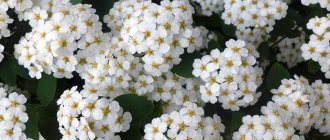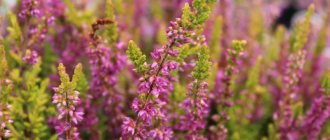Description
Hydrangea serrata (adapted Latin name) is a compact bush 1–1.5 m high. The central trunk is usually thick and branched. Strong shoots grow at a slight upward angle, forming a dense, rounded crown. The bark is gray-brown, greenish on young branches.
Did you know? During archaeological excavations in Alaska, in North America, fossilized particles of hydrangea were found. After analysis, scientists came to the conclusion that the plant grew here more than ten thousand years ago.
Hydrangea serrata or, more correctly, serratifolia is a densely foliated plant. The leaves are medium to large in size, 7–11 cm in length, depending on the variety. The plates are oval with a pointed end and a wide base, mottled with wrinkles. The edge of the leaf is edged with well-defined serrations. Color ranges from light to dark green.
Flowering period: June – September. Inflorescences are spherical or in the form of corymbs. The petals are wavy along the edge. Color ranges from pink and blue to lilac. The flowers cover the bush so thickly that often the foliage underneath is not visible.
Reviews from gardeners
Many gardeners are fond of hydrangeas and often plant serrated varieties in the garden.
Judging by most reviews, the bush requires regular care, especially pre-winter preparation. Although, some gardeners in regions with mild and snowy winters do not cover it at all.
It has been noticed that bushes planted in full shade grow green mass well, but bloom poorly. In rainy seasons, the inflorescences become larger and more lush. To “tint” flowers in blue and blue shades, gardeners acidify the soil with aluminum-potassium alum, citric and succinic acids, and acidic peat.
Popular varieties
Most serrated garden forms were developed in Japan. The varieties are mostly winter-hardy, have immunity against diseases, and are rarely attacked by insects. Serrated hydrangea can be grown in open ground conditions in the middle zone, in the Moscow region, in the Urals and in Siberia. In cold regions, it is advisable to provide crops with shelter.
Bluebird
The height of the bush is no more than 1.2 m, the crown can grow up to 1.5 m. The finely serrated leaves are oval in shape. The color of the plates is bright green. The inflorescences are collected in corymbs with a diameter of 10 cm. The flowers are small in the center, with larger baskets located along the edges. The time for buds to open is July. Bright blue or purple caps remain on the bush until September. Bluebird calmly survives the winter with temperatures dropping to -20°C.
Oamaha
The compact shrub grows up to 1.5 m, while the crown reaches no more than 60 cm in diameter. Oamaha is a large-leaved variety; the length of the leaf can be equal to the size of the inflorescences - 9–12 cm. The green leaves are oval in shape with an elongated sharp end.
The inflorescences are umbrella-shaped, the color depends on the type of flower:
- sterile - blue or pink;
- fertile ones are blue or white.
The flowering period is from June to September.
Important! Soil acidity can change the color of the petals: acidic soil is blue, neutral soil is pale blue, alkaline soil is purple.
Koreana
Large flower baskets can be pink, blue and blue, and on one bush at the same time. The inflorescences are umbellate, densely sprinkle the bush in early July and decorate it until September. Plant height - 1.5 m, crown width - 1.2 m. Foliage with a wide plate of medium size, 7–9 cm in length.
Preciosa
The variety is no more than a meter high. The crown is round and dense. Preziosa produces yellow-green buds at the beginning of flowering. As the petals bloom, they turn pink. And then purple or lilac. Flowering time begins in the second half of July and continues until September inclusive. The variety has high winter hardiness and can be grown in cold regions.
Virl
Giant among other varieties: reaches 2 m in height. Whirl has low growth power. An adult specimen grows a crown 1.5 m wide. It blooms all summer. Purchased flowers are collected in round inflorescences. Petals with a pink or blue tint.
Types and varieties: name and characteristics
There are many varieties and varieties of plants, each of which has certain characteristics. Popular ones include Bluebird, Preziosa, and Koreana hydrangeas.
Small serrated hydrangea Bluebird, or Blue Bird
The description of Blue Bird hydrangea says that this plant reaches a height of 1.5 m. It is characterized by light blue flowers. This variety has excellent frost resistance. The serrated Bluebird hydrangea blooms from late July to early September. The plant is complemented by green, egg-shaped foliage.
Note! Bluebird hydrangea is characterized by a change in petal color from pale pink to deep blue. Planting and caring for Bluebird hydrangea is no different from those for other varieties of shrubs.
If finely serrated Blue Bird hydrangea is grown, the description of the plant must be studied in advance.
Planting and caring for Bluebird hydrangea is no different from those for other varieties of shrubs. If you are growing small-serrate Bluebird hydrangea, the description of the plant must be studied in advance.
Koreana
Hydrangea Koreana reaches a height of 1.5 m. It is characterized by elliptical leaves. Flowers can be white, pink or blue. They form decorative corymbose inflorescences.
Preciosa
This is a low-growing crop that grows to a maximum height of 1.5 m. Hydrangea Preciosa has pink or purple inflorescences. At the beginning of flowering they have a yellow-green color.
For your information! The variety is considered very frost-resistant.
Landing
It is recommended to purchase seedlings from nurseries. When purchasing, you need to inspect the bush. Good planting material has developed shoots with buds, a flexible and moist root system. The soil clod of a seedling with closed roots should not emit an unpleasant odor. To make sure of this, carefully dump the bush out of the container.
Site selection and soil preparation
For a serrated look, you need to choose a flat place, without slopes or holes. The root system of hydrangea is not located deep from the surface, only 40–55 cm, so the bush may not survive on hilly areas, especially if it is strewn with heavy inflorescences.
Check out
Features of planting hydrangeas in open ground
Moisture, rain and melt water accumulate in the lowlands. The plant loves moisture in moderate portions, but not in excess. Diffused lighting is recommended: the shadow will make the inflorescences loose, and too bright and aggressive sunlight will burn the delicate petals and foliage.
The site is dug up and a mineral complex is introduced into the ground:
- urea - 20 g;
- potassium salt - 20 g;
- superphosphate - 25 g.
During digging, all plant debris from last year should be removed.
Landing dates
Planting dates depend on the region where the crop is grown. In the southern regions, planting is possible in the fall, after the heat has subsided and 1.5–2 months before frost. In the central and northern regions, planting is carried out in the spring. It could be April or May. The main condition is that the earth must be warmed up to at least +8°C.
Step-by-step instruction
When planting a group of plants, leave a gap of up to one and a half meters between them. The size of the pit is 50x50x60 cm.
Planting pattern:
- The soil removed from the hole is mixed with peat and sand in a ratio of 2:1:1.
- Some of it is poured onto pre-made drainage made of crushed stone or gravel in a layer of 15 cm.
- A seedling is placed on top and the roots are straightened.
- When the plant is covered with soil, monitor the position of the growth point - 3–5 cm above the ground level.
- Afterwards, watering is carried out using a bucket of water.
The tree trunk circle is covered with a layer of mulch of 6–8 cm. Material - peat, sawdust, tree bark.
Transplanting serrated hydrangeas into open ground after purchase
Hydrangea Hot Red - variety description, planting and care
When growing crops, certain features must be taken into account. The plant requires a substrate of humus, leaves, peat and sand. Recesses for planting must be made in advance. Their size should be 35 cm.
To plant a crop, gardeners advise doing the following:
- Water the hole thoroughly.
- Place a bush in it.
- Sprinkle with soil.
- Compact the soil.
- Water the crop generously.
- Cover the plantings with a mulch layer.
Care
Hydrangea is generally not a whimsical plant. But you need to monitor the soil moisture to prevent the roots from drying out. The plant also requires nutrients and shelter from overheating. No less important is timely pruning, especially sanitary and formative.
Fertilizer
The plant responds well to root and foliar feeding. You should not overdo it with nitrogen, so that the growth of leaf mass does not come at the expense of flowering.
Important! Before adding dry preparations, you need to moisten the soil, otherwise you can burn the roots.
For shrubs, several feedings per season are enough:
- In early spring, foliage growth is stimulated by adding an infusion of bird droppings. The product is diluted with water in a ratio of 1:20.
- When buds begin to form, potassium and phosphorus are needed. To prepare root feeding, you need potassium salt and superphosphate, 30 g/10 l of water.
- During flowering, repeat the previous option, adding 2 g of boric acid to the product.
- The last fertilizer is applied at the end of August. Place 50 g of superphosphate and potassium salt into the soil around the tree trunk.
Watering
The description of the species speaks of the plant’s love of moisture. A short-term drought will not lead to death, but will worsen the quality of flowering. Settled water is used for irrigation; chlorine has a bad effect on plants. An adult bush will need 2-3 buckets of water. A young specimen needs 10 liters of liquid. With frequent precipitation, the frequency of soil irrigation should be reduced: due to excess moisture, the roots will begin to rot.
Read how to properly care for hydrangea in the garden.
Trimming and shaping
In the spring, when inspecting the bush, you should remove weak and broken shoots. Some may be damaged by wind, snow crust, and they are also pruned. To form a beautiful crown, leave the strongest and most even branches. This way they create a backbone. Next, shoots that grow inward and are unpromising are removed from the ring.
Every year the shape is maintained by trimming branches that stick out from the general contour of the crown. Rejuvenating cutting for varieties with fast growth is carried out once every 2-3 years, for slow-growing varieties - once every 5-7 years. The shoots are simply removed onto the stump.
Winter hardiness and shelter for the winter
Serrata hydrangea is resistant to low temperatures; many varieties can withstand -25...-30°C.
Young bushes in cold regions need careful preparation for winter:
- Mulch from sawdust or tree bark in a layer of 25 cm.
- Installation of a circular support on which the agricultural material is pulled.
- Spruce branches and snow crust when snow falls.
It is enough to mulch adult bushes. If the crop grows in an open area, it is advisable to tie the branches with twine so that they are not broken by the wind and the weight of the fallen snow.
Read more about the rules for covering hydrangeas for the winter.
How to prune correctly?
Hydrangea is pruned in the fall. The shoot is cut into two buds. Thin shoots are removed, the thick crown is thinned out. Pruning promotes the appearance of large inflorescences.
To propagate hydrangea by cuttings, it is pruned in the spring, when the plant is at least 3 years old. It is necessary to prune the hydrangea at the level of the fourth bud. And divide the cut part into cuttings. The cutting will have two nodes. The lower part of the cutting is placed in soil with peat and sand, 3 cm deep. Water is not spared. After the cutting takes root, it is planted in a permanent place. By autumn the bush will grow. And he will be able to winter well.
Diseases and pests
Proper and attentive care will protect the crop from diseases and pest attacks.
And yet you should familiarize yourself with the methods of dealing with possible misfortunes:
- With fungal diseases such as powdery mildew, septoria, the biological fungicide “Gamair” does an excellent job. The solution for spraying the bush is prepared in the proportion of 2 tablets/10 liters of water.
- Root rot and tracheomycosis can be combated using another biological agent - Alirin-B. A working infusion for watering the tree trunk and foliage is made from 2 tablets and 10 liters of water, stirring thoroughly.
- “Akarin” is effective against leaf-sucking and leaf-eating insects ( aphids , thrips , mites The bush should be sprayed with a solution in the proportion of 2–6 ml/1 liter of water.
- Soil pests (weevil, slugs) are vulnerable to the active ingredient of the Apache insecticide. To water the bush, you need to dissolve 1 g of the product in a liter of water.
To prevent harmful insects from annoying the area, flower growers plant repellents next to ornamental crops. These plants repel almost all garden pests with a pungent odor.
Know why hydrangeas are pruned
A neglected appearance, sluggish flowering, small bud heads are a consequence of lack of care. Without pruning, the branches grow randomly and become excessively elongated. Long shoots cannot withstand the weight of the inflorescences: they bend to the ground or break.
A thickened plant has a lot of weak growth, which does not produce full flowering and depletes the plant.
Main purposes of pruning:
- removal of excess growth;
- crown formation;
- thinning;
- rejuvenation;
- cleansing of broken, frozen, weakened branches;
- shortening too long shoots.
Tree-like Annabelle Pink is an example of correct formation
Reproduction options
Flowers of serrated species consist of sterile and fertile flowers, so they can reproduce by seed. It is better to buy seeds from trusted sellers. They should be dried before planting. In addition, the method of cuttings and layering is very successful and simple.
Learn in more detail the best methods and timing for propagating hydrangeas.
Seeds
Sowing is carried out in February. A few days before, the seeds are placed in damp cotton wool to swell. Sow the material in wet sand, covering the container or pot with glass. For several weeks, every 2–3 days the seedlings are sprayed and condensation is removed from the glass. When sprouts appear, the cover is removed. With the appearance of the first pair of strong leaves, the seedlings dive into separate containers.
The substrate is taken as for a seedling. Until the plant grows up and forms a strong root system, it is kept in the house, on a lighted windowsill. Care consists of watering and fertilizing. Fertika fertilizer is applied to the soil twice a month, 5 g per pot. In autumn, feeding is stopped until spring. A 2–3-year-old bush is transplanted into open ground.
Read more about how to grow hydrangea from seeds.
By cuttings
Cuttings are taken at the beginning of summer from shoots of the current season. You need a piece of branch 6–8 cm long with 2 internodes and a pair of leaves. Root in wet sand, placing it in the substrate at an angle. The shoot is covered with a piece of plastic bottle. Regularly ventilate and spray the soil every 2-3 days. Next spring, the grown, rooted bush is transplanted to a permanent place.
By layering
Layers can be propagated at any time of the year, except late autumn and winter. You need to choose the longest branch from an adult plant. A narrow groove no more than 15 cm deep is dug under it. Part of the shoot, cleared of foliage, is placed in it.
Did you know? Buddhists have a tradition: on Buddha's birthday, tea from hydrangea leaves, called "amacha", is poured on the head of the statue of the deity in the temple.
The layering is sprinkled with soil, and its upper part is left on the surface. When caring for the mother bush, attention is also paid to the seedling. Next spring, the cuttings with roots are carefully separated from the donor and planted in a permanent place in the garden.
Hydrangea with serrated leaves will adequately decorate any corner of the site. Properly selected varieties and types of crops will turn the garden into a continuously blooming paradise.
Pruning and propagation by cuttings of Hydrangea Serrata
Pruning is done in the autumn garden. The shoot is cut into two buds, and the entire bush is leveled at this level. Then thin shoots without inflorescences are removed, and the dense crown is thinned out. After such pruning, the inflorescences will be larger.
To propagate serrata hydrangea by cuttings, it is pruned in the spring at the age of three, when the buds begin to appear. Pruning is done at the level of the fourth highest bud, and the cut part is divided into cuttings. The cutting will have two nodes. Under the lower knot it is oblique, under the upper knot it is straight. The distance from the node to the cut is two centimeters. The lower part of the cutting is placed three centimeters deep in soil with peat and sand, sparing no water, and watered. The rooted cutting is planted in a permanent place and by autumn a bush will grow that can overwinter well.
Ornamental shrub Bretschneider's hydrangea
In terms of habit, the ornamental shrub Brettschneider hydrangea, found in 1882 in the vicinity of Beijing, is more reminiscent of lilac or large mock orange. Its height is up to 4 m. It can grow in the form of a bush or tree, is very frost-resistant, durable, does not bother with shoots, and does not require any supports. Compared to other hydrangeas, it is drought-resistant. This miracle blooms annually and very profusely, covered with slightly fragrant inflorescences about 15 cm in diameter.
As you can see in the photo, the flowers of Bretschneider's hydrangea are initially milky white, later turning pink and purple:
The color of the inflorescences may change with changes in soil acidity. This type of hydrangea has flowers collected in large umbrella-shaped, slightly convex shields that remain on the plant for a long time, until late autumn.
The fruits - dry capsules - ripen in September. Blooms from 5-6 years.
Bretschneider's hydrangea (N. bretschneideri) propagates by seeds and cuttings.
Cuttings usually root without problems. The root system of hydrangea is superficial and branched. Hydrangea can grow in partial shade and sun. Moreover, it blooms better in full sun, but it needs to be watered there, otherwise the leaves may dry out and burn.
Does not like calcareous soils and windy places. Does not tolerate winter dampness; the soil must be sufficiently permeable.
Trim the bush before sap begins to flow. Strong faded shoots are shortened to a well-developed node with buds, and all old, weak and frozen ones are cut out. Feed hydrangeas with special fertilizers for hydrangeas, rich in magnesium and iron.
Bretschneider's hydrangea is a unique plant. This is a magnificent background in a shrub mixborder, an element in a shrub group that you want to see blooming in the second half of summer.
Look at the photo - this type of hydrangea looks great in autumn and winter in combination with viburnum, hawthorn, and Koehne rowan (with white fruits):
With these plants, hydrangea also looks interesting in summer thanks to the contrasting foliage.
For a long time, Bretschneider hydrangea was impossible to buy. Now domestic nurseries have begun to grow it.
Bretschneider hydrangea varieties are sometimes found in Western European nurseries:
'Snowcap'
'Jermyn's Lace'
The diameter of their inflorescences is gigantic - from 25 to 30 cm. It is unknown how the varieties will fare in central Russia.
Hydrangea Bluebird in landscape design
Landscape design experts recommend planting serrata hydrangea to give the area a blooming appearance. In the process of creating any composition, you need to take into account the fact that the distance between plants should be at least 1.5 m.
The flowering shrub goes well with astilbes or astrantias. Fans of minimalism will love the combination of Blueberry with lilac or mock orange. If there is a pond in the garden, then hydrangea can decorate its coastal zone. Thanks to its high frost resistance, the shrub will delight its owners from early spring to late autumn.
Important! To obtain a pink tint of flowers, designers recommend watering the plant with a weak solution of potassium permanganate; to color the flowers deep blue, use an aqueous solution of potassium alum.
Below are photos of the use of Bluebird serrata hydrangea in landscape design.
The plant is planted as a hedge along the garden path
The combination of different varieties allows you to achieve the natural brightness of a living fence
The view from the window of a blooming flowerbed will extend summer until October
Preparing for winter
The serrated hydrangea Bluebird tolerates cold quite well in central Russia , but it is necessary to build a shelter until the plant gets stronger, that is, up to 4-5 years.
You will also have to protect the shrub for the winter in northern and cold regions.
Work is carried out adhering to the following rules:
- First you need to carry out sanitary pruning.
- Then phosphorus and potassium fertilizers are scattered under the bush.
- In frosts down to -5 degrees, the bush is hilled and covered with polyethylene.
- Down to -15 degrees, hydrangea is tied with a rope, spud, covered with spruce branches, and a film is wrapped on top.
- At temperatures down to -20 degrees, the branches are bent to the ground and secured with metal brackets; sawdust, pine branches, old blankets, etc. are laid on top.
- In frosts down to -30 degrees, the shrub is wrapped in a metal lattice, covered with bricks and covered with old warm clothes on top.
Read also: Hydrangea sterilis garden planting and care in open ground
If you properly prepare hydrangea for winter, then in the spring the plant will begin to grow faster.
It is necessary to protect shrubs for the winter in northern and cold regions
Tips for Growing Hydrangea
It is recommended to rejuvenate the bushes every 2-3 years, while old branches and trunks are cut out.
There are two types of plant pruning:
- With severe pruning, branches with 2-3 buds are left, the inflorescences are large, but there will be fewer of them.
- If it is weak, the tops of shoots with 2 or 3 buds must be removed, as a result - many small inflorescences.
If you water the plant with a slightly colored solution of potassium permanganate during the formation of buds, the flowers will turn from white to pink.
To obtain blue-blue inflorescences, it is recommended to pour a solution of aluminum-potassium alum under the bush twice a month - 3-5 grams per 1 liter of water.
Let's summarize: the plant loves watering and fertile acidic soils, grows best in the sun or light partial shade. For the winter it is better to cover not only the roots, but also the bush itself.
Try planting serrated hydrangea in your garden. And she will thank you for your care and patience with impossibly beautiful flowering.
More information can be found in the video.
